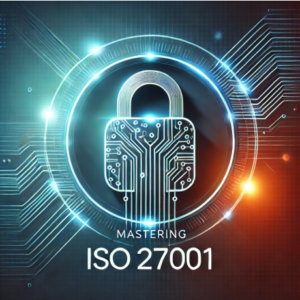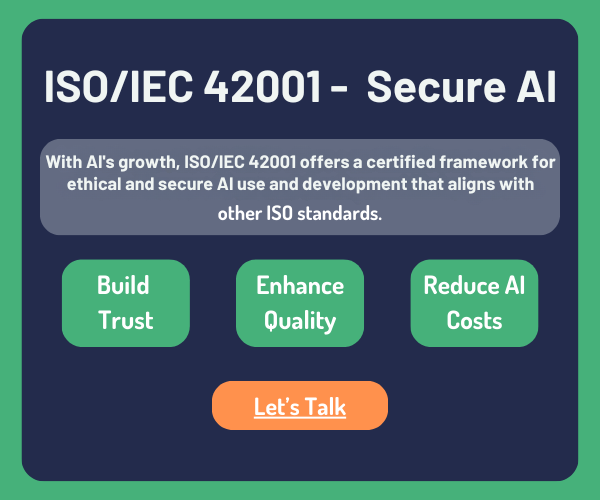In this article
Designing an Artificial Intelligence Management System (AIMS) for ISO 42001 Compliance
- Jorge Sandoval

Explore How to Build a Scalable, Ethical, and Audit-Ready AI Management System That Meets ISO 42001 Requirements
As artificial intelligence moves from experimental to essential, organizations must shift their focus from building models to governing them responsibly and strategically. That’s where an Artificial Intelligence Management System (AIMS) becomes indispensable.
AIMS is the operational foundation of ISO 42001—the system through which organizations manage AI risk, align with ethical principles, and maintain compliance at scale. In this guide, we break down how to design, implement, and future-proof an AIMS that enables both growth and trust.
What Is an AIMS and Why It Powers ISO 42001 Compliance
An Artificial Intelligence Management System (AIMS) is the integrated set of processes, policies, and controls your organization uses to ensure that AI systems are:
✅ Safe
✅ Ethical
✅ Transparent
✅ Secure
✅ Compliant with global regulations
Think of AIMS as the AI governance equivalent of an Information Security Management System (ISMS) under ISO 27001. It goes beyond managing a single algorithm—AIMS governs the entire AI lifecycle, from data intake and model training to deployment and continuous monitoring.
Why Is ISO 27001 Important?
In today’s world, cybersecurity and Infosec (Information Security) are crucial. ISO 27001 helps organizations minimize the risk of data breaches, comply with regulations, and build trust with customers. The standard focuses on both preventing risks and improving your systems over time.
Why AIMS Is Critical for ISO 42001
ISO 27001 is broken into several sections (called clauses) that outline the steps you need to follow to build and maintain an effective ISMS. While the document contains ten clauses, Clauses 4-10 are the ones you need to focus on for compliance.
ISO 42001 is built entirely on the foundation of a functioning AIMS. Certification requires your organization to demonstrate a structured, auditable approach to:
- AI governance and accountability
- Risk and impact assessment
- Bias and fairness controls
- Human oversight and intervention
- Lifecycle documentation and traceability
- Data quality and security
- Continuous learning and system improvement
Without AIMS in place, organizations simply cannot meet the baseline requirements for ISO 42001 certification (UNESCO, 2023).
Core Components of a Scalable AIMS
Component | Purpose |
AI Policy & Objectives | Define your commitment to responsible AI aligned with organizational goals |
Governance Structure | Assign accountability—AI risk officer, ethics board, compliance lead |
AI Risk Management Process | Identify, assess, and mitigate risks specific to AI models and systems |
Data Governance Controls | Manage data quality, privacy, lineage, and security |
Human Oversight Protocols | Ensure decisions are explainable and overrideable by human reviewers |
Monitoring & Logging | Continuously track AI behavior, drift, and system performance |
Training & Awareness | Equip teams with clear roles and responsibilities under AIMS |
Audit & Documentation | Maintain full traceability for reviews, incidents, and external audits |
Step-by-Step: How to Build an ISO 42001-Compliant AIMS
Step 1: Align With Business Strategy
Your AIMS should reflect your specific AI ecosystem and business risk profile. Start by clarifying:
- Are you building or buying AI?
- Are AI tools embedded in regulated workflows like healthcare, finance, or HR?
- What are your reputational, legal, and operational exposures?
Understanding your AI risk footprint is the foundation for a tailored, effective AIMS strategy.
Step 2: Define Governance Roles
AI governance requires clear accountability. Assign roles such as:
- Project approval and review
- Ethical oversight sign-off
- Incident monitoring and escalation
Many organizations establish an AI Risk Council or embed AIMS responsibilities into existing GRC committees.
Step 3: Develop Risk Frameworks
Build your AI-specific risk approach with:
- A standard risk assessment template
- Bias and explainability checks
- Human-in-the-loop criteria for model rejection or override
These directly align with Annex A of ISO 42001 and other leading frameworks like the NIST AI Risk Management Framework.
Step 4: Build Out Policies and Procedures
Start with existing security, privacy, and compliance policies. Expand to include:
- AI-specific data governance and training dataset documentation
- Explainability thresholds for model outputs
- Decommissioning policies for obsolete or unsafe models
This ensures your AI operations are documented, defensible, and aligned with global best practices.
Step 5: Implement Monitoring and Continuous Improvement
Design real-time monitoring dashboards and governance logs to track:
- AI behavior and performance drift
- Incident alerts and review workflows
- Risk trends and control effectiveness
Schedule internal audits and management reviews regularly to refine your AIMS and support continuous improvement (NIST, 2023).
AIMS + ISO 27001: A Unified Compliance Strategy
If your organization already maintains ISO 27001, GDPR, or SOC 2 readiness, you’re in a strong position to accelerate ISO 42001 certification.
Here’s how to integrate efficiently:
- Reuse access control, audit, and privacy policies
- Map ISO 42001 Annex A controls to existing ISO 27001 frameworks
- Extend risk registers to include algorithmic and ethical risk
- Embed AIMS into your broader GRC or compliance platform
AIMS doesn’t replace your ISMS—it enhances and extends it to address modern AI risks (European Commission, 2023).
Final Thoughts
Designing a compliant AIMS isn’t just about meeting ISO 42001—it’s about building a governance infrastructure that supports responsible AI innovation at scale.
At Consilium Labs, we help companies move from fragmented AI oversight to audit-ready, fully aligned management systems that protect stakeholders, mitigate risk, and unlock enterprise growth.
📩 Ready to certify your AIMS with confidence? Let’s Talk →
Consilium Labs helps you assess ISO 42001 readiness through impartial gap assessments and audit-focused evaluations.
Related Articles
Let's get in touch
Start your audit now. Achieving cybersecurity audit can be complex. We have made it our mission to simplify the process, giving you access to the professional expertise you need to prepare your company for the future. Get in touch with us today!





